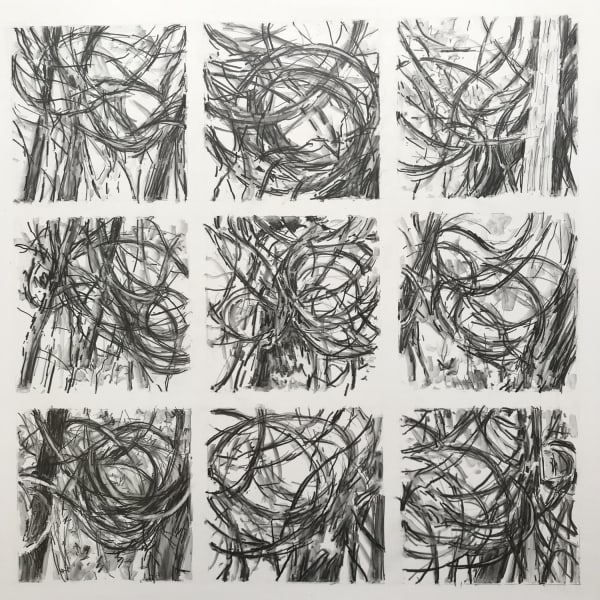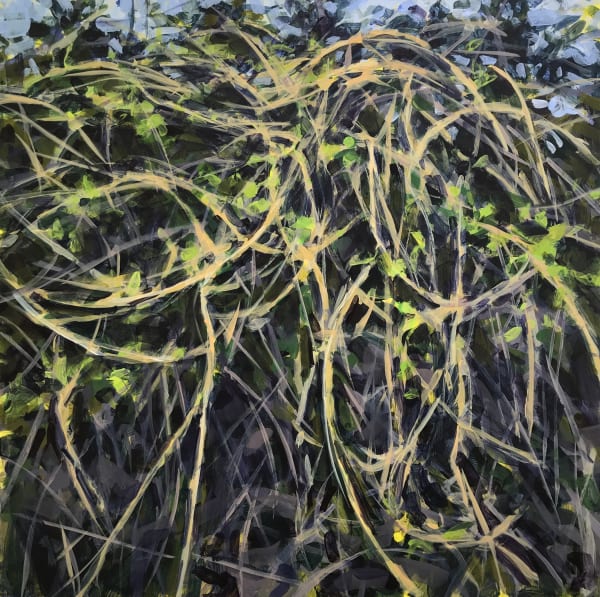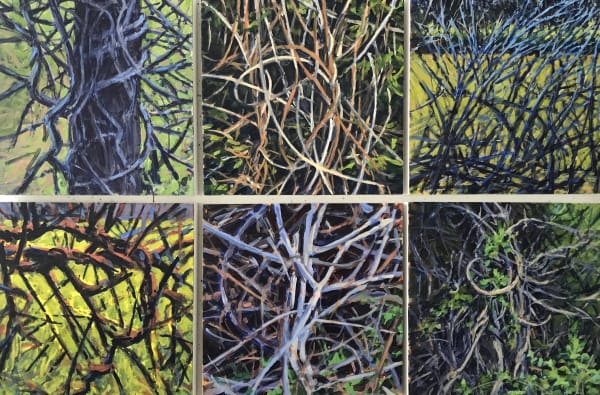We are thrilled to be showing the work of Nina Jerome at the gallery right now in her "Entangled Space" exhibit. She graciously took the time to answer some questions about her work and the pieces in the exhibit and we are excited to share them with you today.
Your exhibit at the gallery is entitled “Entangled Space”. Can you tell us a bit about the show and what inspired you to create these pieces? Can you share how you came to choose your subject of vines and trees?
"I spent the month of April 2017 at the Virginia Center for the Creative Arts in Amherst, VA. I had planned to work on drawings and paintings of aerial views from photographs I had taken while traveling, and started this work, creating charcoal drawings of views from above. Despite my plans, I worked outside, in the warm Virginia spring, searching for distinctive qualities of that landscape that differed from Maine. I was drawn to the movement in honeysuckle and wild grape. They were calligraphic, complex, and chaotic, and differed from forms I had seen before. As the vine drawings developed and hung on the studio wall beside the aerial views, I was struck by the similarities between the structures of both the invasive vines and the development of roadways on the land. It was almost as if my work with the New Jersey turnpike and curving suburban roads led me to the vines. I became more interested in the vines and continued to work on them for 2 ½ years, returning to VCCA in 2019 to paint the small acrylic pieces of honeysuckle and kudzu."
I understand you spent some of this summer in Monson as one of the first artists to teach in a new artist residency there. What was that like? Did you enjoy your time there?
"Teaching at Monson Arts was a wonderful experience. My class of ten enthusiastic outdoor-oriented individuals spent time drawing outside at varied, natural sites, then, worked in the spacious studio developing paintings from their drawings. Being together all day, sharing meals, then, returning to our work in the studio, quickly solidified our group. Students worked hard and the experience promoted a substantial amount of quality work. The Libra Foundation has built an inspiring location for the arts in Monson."
I know you have also completed residencies in Iceland, Virginia and Great Cranberry Island. How did your experiences differ from place to place and how did each location inspire you?
"Maine islands where I have spent residency time (Great Cranberry and Great Spruce Head) are magical. The light, intimate spaces, varied shorelines, and vistas are awe inspiring – it’s hard to sort out where to look first, so one takes some time, explores, and lets the observations and drawings lead to further work.
VCCA provides a large community of artists with which to interact as well as a landscape that is very much softer than that of Maine. I have worked there in April where I love to watch spring unfold.
The Icelandic landscape that I observed during a residency at Hafnarborg in Hafnarfjordur was dark, powerful, and monumental. Everywhere, I saw movement passing through massive, richly surfaced landforms. These qualities impressed me, as I painted waterfalls, cliffs, tumbling rocks, and dark clouds."
What do you feel is the role of a residency in an artist’s development?
"Being at a residency says to me – “OK, you’re here. Now make the best use of this time.” As a landscape painter, the change in perspective is an inspiring challenge. I ask myself - What is distinctive about this place that I want to express? How does it relate to my work? What do I see here that I could not observe at home and what does it express? I also enjoy spending time with other visual artists, writers, musicians and comparing notes about the creative process.
The pieces in “Entangled Space” are similar to works on display at the University of Maine, Bangor. You had mentioned to Liz that there have been some interesting interpretations of the pieces. Could you share some of your favorite interpretations?
The pieces in this exhibition are from the same series as those at the University of Maine Museum of Art, however the Bangor show has more emphasis on the abstract development of the ideas with its grids and expressionistic color, and these works represent more directly my observation of the structure and space. I was aware as I worked that the chaos and complexity of this landscape expressed many ideas inherent in the interconnected systems of contemporary life, and I love it when viewers relate it to their own thoughts. The human body, climate change, human interactions in literature, as well as political issues have been some of the responses that I have heard."
I know it must be hard to choose but do you have a favorite painting from this exhibit? If so, why is it a favorite?
"I don’t have a favorite – When I work I become very involved in the challenge of marks, color, and design of each piece so that it fully occupies my head in almost an obsessive way. After I finish the work and the struggle becomes more distant, I become more objective, stand back and wonder, “How did that happen”? I loved the process of this series and became attached to each step in its evolution. The initial gestures and plein air paintings led to small studio drawings and paintings. From there I wanted bigger paintings, then cropped the most complex areas for more highly charged square format designs. This led to more abstract drawings, grids, (graphite study for “Thicket”, a twelve foot square grid at UMMA) and new arrangements of the structure. My favorite part of this series was the PROCESS."
You have had a studio in Bangor for over 40 years. What do you like about your space?
"I have been in two studios in Bangor. My present space looks out across two streets coming into downtown, has wonderful light, and has several work areas so that many pieces can be in process at one time. I like feeling the energy of downtown as I work."
Can you share your process for creating your paintings?
"This “Entangled” series tapped into ideas about process for me, and I love that the sequence of drawings and paintings are visible in both exhibitions. It takes time to absorb a space, and to determine if and why it interests me. I make quick, small drawing studies to test out ideas. I’m aware that each drawing holds potential for a more complex work. I also photograph and use the drawings and photographs in the studio to develop paintings. I often tone the canvas to insure color surprises, and use many transparent layers of color. In a series of paintings, ideas from one painting lead to another, as the entangled spaces led to close-ups of branches, led to cropped square studies, led to grids."
October 21, 2019







